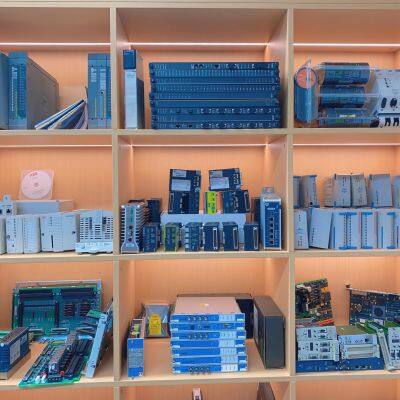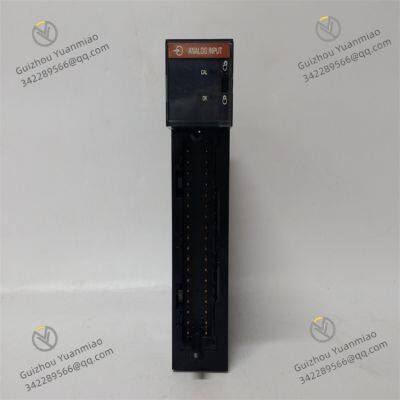Product Description
I. Overview
1756-IF16 is a high-performance analog input module in Rockwell Automation's ControlLogix series, specifically designed for large-scale analog signal acquisition in industrial automation systems. It can accurately receive analog signals from various devices such as temperature sensors, pressure transmitters, and flow sensors, convert them into digital signals recognizable by the ControlLogix processor, and provide comprehensive and reliable raw data for real-time monitoring, closed-loop control, and data analysis in industrial production processes.
This module is widely used in large-scale industrial scenarios. For example, in the production workshop of a large chemical plant, it can simultaneously collect temperature, pressure, and liquid level signals from dozens of reaction tanks; in the steel rolling production line of a steel mill, it can gather temperature and pressure parameters of multiple rolls; in large water treatment plants, it can monitor water quality-related analog signals in different treatment links. As one of the core input modules of the ControlLogix system, 1756-IF16 works collaboratively with processors, output modules, etc., providing strong support for building efficient and stable large-scale industrial automation control systems, ensuring the precise operation and quality control of large-scale production processes.

II. Technical Parameters
Number of Input Channels: Equipped with 16 independent analog input channels, capable of simultaneously collecting 16 channels of analog signals. It can meet the needs of multi-parameter and large-scale monitoring in large industrial equipment or production lines, reduce the number of modules used, and optimize system layout and costs.
Input Signal Types: Supports various common analog input signal types, including current signals (such as 4-20mA DC) and voltage signals (such as 0-10V DC, ±5V DC, etc.). The signal type of each channel can be flexibly configured through software, with extremely strong compatibility, and can adapt to most industrial analog sensors and transmitters.
Resolution: The resolution reaches 16 bits, which can accurately identify tiny signal changes. For example, within the 4-20mA current signal range, it can distinguish subtle differences of 0.006mA, ensuring high-precision acquisition of analog signals and providing accurate data basis for control systems.
Accuracy: The measurement accuracy is high, generally within ±0.1% of the full scale (the specific accuracy value varies depending on signal type, range, and environmental conditions; refer to the product manual). It can ensure the accuracy of collected data, reduce the impact of measurement errors on control decisions, and is suitable for large-scale industrial scenarios with strict requirements on parameter accuracy.
Sampling Rate: The single-channel sampling rate can reach a high level, for example, each channel can sample more than 200 times per second (specific values are subject to the product data sheet). The rate remains stable during simultaneous multi-channel sampling, which can timely capture rapidly changing analog signals and meet the needs of real-time monitoring and control in large-scale production processes.
Isolation Method: Adopts inter-channel isolation or group isolation design, with an isolation voltage usually of 250V AC. It can effectively suppress electromagnetic interference and common-mode interference between different channels, improve the anti-interference ability of the module in complex industrial electromagnetic environments, and ensure the stability of large-scale signal acquisition.
Power Requirements: Power is obtained from the ControlLogix rack backplane, with moderate typical power consumption. The current consumption is approximately 700mA at 5V DC (specific parameters are subject to the product data sheet), which has little impact on the system power load, ensuring stable power supply to the system.
Environmental Adaptability Range:
Operating Temperature: Can work normally in the temperature range of 0°C to 60°C, adapting to large temperature fluctuations in industrial production sites, and can run stably in both high-temperature smelting workshops and normal-temperature control rooms.
Relative Humidity: Can withstand 5% to 95% non-condensing relative humidity, and can still maintain reliable signal acquisition performance in humid environments such as food processing workshops and paper mills.
Dimension Specifications: Adopts the standard module size of the ControlLogix series, perfectly matching the 1756 series rack, with convenient installation, no additional space occupation, and easy integration and later maintenance of large systems.

III. Functional Features
Large-scale Signal Acquisition Capability: 16 independent input channels can simultaneously collect 16 channels of analog signals, which can centrally process various analog information from large production lines or equipment, reduce the number of modules used in the system, lower system costs, simplify on-site wiring, and improve system integration.
High-precision Signal Conversion: 16-bit resolution and high measurement accuracy ensure that the module can accurately capture subtle changes in analog signals. For key parameters that need precise monitoring in large-scale production processes (such as temperature fine-tuning of chemical reactions, pressure control of precision rolling, etc.), it can provide accurate data support, ensuring the stability of the production process and the consistency of product quality.
Flexible Signal Adaptation: Supports multiple current and voltage signal types, and the signal type and range of each channel can be independently configured through software. It can adapt to different types of sensors and transmitters without replacing hardware, greatly improving the versatility and flexibility of the module, and adapting to diverse signal acquisition needs in large-scale industrial scenarios.
Fast Response and Real-time Monitoring: The high sampling rate enables the module to timely capture dynamic changes of analog signals. For rapidly changing parameters in large production lines (such as material flow fluctuations of high-speed conveyors, sudden temperature changes of large furnaces, etc.), it can quickly collect and transmit them to the processor, enabling the control system to respond in a timely manner and avoid production accidents caused by signal delays.
Reliable Isolation Protection: The isolation design between channels effectively blocks electrical interference between different channels, preventing electrical faults of one channel from affecting the normal operation of other channels. At the same time, it protects core equipment such as the ControlLogix processor from interference and damage from external signals, improving the reliability of the entire large-scale automation system.
Comprehensive Diagnostic Functions: The module has strong self-diagnostic capabilities, which can real-time monitor its own operating status (such as power failure, channel overload, signal abnormality, etc.), and communicate with the processor through the backplane to report diagnostic information in real-time. At the same time, it supports the detection of faults such as sensor disconnection and short circuit, facilitating engineers to quickly locate and troubleshoot problems in large systems, shorten fault handling time, and reduce production downtime losses.
Easy Integration and Configuration: As a standard module of the ControlLogix series, 1756-IF16 has excellent compatibility with other modules in the series and can be seamlessly integrated into large ControlLogix systems. Through Rockwell Automation's Studio 5000 programming software, engineers can conveniently complete module parameter configuration (such as signal type, filtering parameters, etc.), channel calibration, and data mapping without complex programming, reducing the technical threshold of large-scale system integration.
Industrial-grade Stability: Adopting industrial-grade high-quality components and a robust structural design, it has good anti-vibration and anti-impact performance, can withstand mechanical stress and strong electromagnetic interference in large industrial sites, ensures long-term stable operation in harsh industrial environments, and reduces large-scale production interruptions caused by module failures.

IV. Operation Guide
Installation Steps:
Preparation: Confirm that the installation environment meets the module's environmental adaptation requirements, and the rack power supply is turned off. Prepare necessary tools such as screwdrivers and insulated gloves, and check whether the module's appearance is intact and whether the connectors are damaged or deformed.
Rack Installation: Align the 1756-IF16 module with the idle slot of the ControlLogix 1756 series rack, push it smoothly along the guide rail to ensure that the module is in close contact with the rack backplane, then firmly fix both sides of the module with screws to prevent the module from loosening due to vibration during equipment operation.
Wiring Connection: According to the module's wiring diagram and the signal type (current or voltage) of the sensor/transmitter, use shielded wires to connect the output signal of the external device to the corresponding input terminal of the module. Pay attention to strictly distinguishing the positive and negative polarities of the signal and the ground terminal, ensure the wiring is firm and correct, and the shield layer should be properly grounded to enhance anti-interference ability. After wiring, carefully check each wiring to avoid wrong connection or virtual connection.
Power On: After confirming that all connections are correct, turn on the rack power supply, and the module will start initialization. At this time, the status indicator of the module can be observed. If the indicator shows normal (such as the power light is on and no fault light is on), it indicates that the module starts normally.
Configuration Process:
Software Preparation: Install Studio 5000 software on the programming computer and ensure that the software version is compatible with the module. Establish a stable communication connection between the computer and the ControlLogix processor through a programming cable.
Module Addition: Open the corresponding project in Studio 5000 software, enter the I/O configuration interface, add the 1756-IF16 module according to its actual installation position in the rack, and the software will automatically identify the module model.
Parameter Configuration: According to the signal type (such as 4-20mA, 0-10V, etc.) of each sensor/transmitter in actual application, independently configure the corresponding signal type and range for each channel in the software. At the same time, signal filtering parameters (such as filtering time) can be set according to on-site interference to reduce the impact of signal noise and ensure the stability of the collected signals.
Channel Calibration: For large-scale industrial scenarios with extremely high precision requirements, each channel of the module can be calibrated through software (including zero calibration and full-scale calibration). The calibration process requires the use of a high-precision standard signal source, and follow the software prompts step by step to ensure the accuracy of the data collected by each channel.
Data Mapping: Associate the data collected by the 16 channels of the module with the internal tags of the processor respectively, so that the processor can accurately read and process each channel of the collected analog data. After completing the configuration, download the project to the ControlLogix processor.


Allen-Bradley 1756-L71 Programmable Automation Controller
High Precision Zygo 8010-0105-02 ZMI-501 Displacement Measurement Interferometer
Advanced ZYGO ZMI-4104 High Performance Measurement Board
Reliable ZYGO ZMI-4004 Precision Measurement Board
Superior ZYGO 4104C Electronic Measurement Board
Professional Zygo 7702 8070-0102-35 High Power Laser Head
Durable Zygo 1115-801-346 High Quality Laser Head Cable
Innovative Zygo ZMI-2002 8020-0211 Dual Axis 6U VME High Accuracy Measurement Board
Allen-Bradley 1756-L72S Programmable Automation Controller
Allen-Bradley 1756-L73 Controller
Allen-Bradley 1756-L84ES Controller
Allen-Bradley 1756-M16SE ControlLogix SERCOS Interface Module
Allen-Bradley 1756-OA16I Discrete AC Output Module
Allen-Bradley 1756-OB16E Digital I/O Module
Allen-Bradley 1756-OB32 Discrete Output Module
Allen-Bradley 1756-OF8 ControlLogix Analog Output Module
Allen-Bradley 1756-OW16I Discrete Output Module
Allen-Bradley 1756-PA75 ControlLogix AC Power Supply
Allen-Bradley 1756-PSCA2 Chassis Adapter Module
Allen-Bradley 1756-RM ControlLogix Enhanced Redundancy Module
Allen-Bradley 1756-RM2 ControlLogix Redundancy Module
Allen-Bradley 1336-BDB-SP46D Pcb Circuit Board
Allen-Bradley 1336-PB-SP11A Advanced Control Module
Allen-Bradley 1336-SN-SP10A Adjustable Frequency AC Drive
 yezi
Hi there! Welcome to my shop. Let me know if you have any questions.
yezi
Hi there! Welcome to my shop. Let me know if you have any questions.





